Key takeaways
An Employment Authorization Document (EAD) is a work permit issued by the U.S. Citizenship and Immigration Services (USCIS) that allows certain noncitizens to work in the United States legally.
To renew an EAD, applicants must file Form I-765, the required supporting documents and fees, or a fee waiver if eligible.
Depending on the applicant’s eligibility category, additional steps may include completing biometrics appointments or responding to USCIS Requests for Evidence (RFEs).
Employment Authorization Document (EAD) renewals are an ongoing requirement for many immigration law clients, and a critical workflow for the law firms that support them. When handled proactively, renewals help clients avoid costly employment interruptions. However, even small mistakes can jeopardize the client’s continued ability to work legally and result in stress and potential loss of income for the client.
We created this guide for immigration law firms and general practitioners expanding into immigration law. It offers a clear, high-level EAD renewal checklist that firms can use to streamline processes, reduce client confusion, and scale their practice with repeatable systems. While the core process follows Form I-765 instructions, exact documents vary depending on each client’s situation.
We encourage you to consult the U.S. Citizenship and Immigration Services (USCIS) site for the most up-to-date guidance on how to renew an employment authorization card. What follows is a standard framework your firm can rely on and optimize with automation tools like MyCase’s Immigration Smart Forms.
Step 1: Determine Renewal Eligibility and Client Scenario
Before completing any forms, check two key details to help you determine how to renew your client’s EAD card:
The client’s EAD expiration date
Their eligibility category
These determine whether your client qualifies for an automatic extension, needs to file early, or must submit additional supporting documents. For example, specific categories receive a 540-day automatic extension if filed on time, while others do not.
You can track expected delays using your internal docketing system or consult the Adjustment of Status timeline.
Humanitarian-Based
Clients in this category often require extra care, particularly in making sure they understand all instructions and requests to provide the firm with specific supporting documentation. In particular, humanitarian clients, such as asylees or refugees, may experience significant life changes impacting their eligibility status.
For example, an asylee client renewing after several years in the U.S. may have expired documentation or need to obtain proof of eligibility for work authorization. Moreover, some asylees and refugees change addresses during their first years in a country as they settle into new lives. Therefore, it’s important to verify where they are living and whether they can reliably receive mail at that address. Law firms can build extra time into their workflow to confirm continued eligibility and retrieve updated status documents from prior filings or immigration records.
Supporting evidence may include:
USCIS asylum grant letter, Immigration Judge decision, or I-94 showing asylum status
Approval notices for Temporary Protected Status (TPS) both initial grant and all subsequent renewals
USCIS approval notice for Violence Against Women Act (VAWA) self-petitions (Form I-360)
Prima facie determinations for pending VAWA cases
Approval notices for U or T nonimmigrant status (Form I-918 or I-914)
Common statuses include:
Refugee (a)(3)
Asylee (a)(5)
Withholding of Removal (a)(10)
VAWA Self-Petitioner (c)(31)
TPS (a)(12), (c)(19)
U Nonimmigrants (a)(19)
T Nonimmigrants (a)(16)
Education-Based
Clients in this category are typically F-1 or M-1 students applying for work authorization during or after their academic program. These applications often align with Optional Practical Training (OPT), STEM extensions, or practical training under M-1 status. Accuracy is essential because timelines and documentation are tightly linked to school records and Student and Exchange Visitor Information System (SEVIS) tracking.
Supporting documents may include:
A previously issued SEVIS number
Recent Form I-20 endorsed by the Designated School Official (DSO)
A job offer letter (for STEM extensions)
Proof of E-Verify employer participation
Copy of a prior EAD if applicable
Always verify that the Form I-20 is signed within the USCIS-required timeframe and that employer and training details are current.
Common statuses include:
Student Seeking Pre-Completion Optional Practical Training – (c)(3)(A)
Student Seeking Post-Completion Optional Practical Training – (c)(3)(B)
Student Seeking 24-Month STEM OPT Extension – (c)(3)(C)
M-1 Student Seeking Practical Training After Completion of Studies – (c)(6)
Employment-Based
This category includes nonimmigrant workers and their dependents who qualify for employment authorization due to their visa classification. Clients in this group often work under specialized or treaty-based arrangements, are employed by foreign airlines or organizations, or are spouses of principal visa holders.
In some cases, the applicant is authorized for employment under an adjustment category related to job-based immigration.
Supporting documents may include:
Proof of lawful nonimmigrant status, such as Form I-94
An employer support letter
Pay stubs
Visa approval notices
Documents that verify the employer’s business operations or treaty qualifications
Poof of principal visa holder’s status and employment for dependent spouses
Common statuses include:
B-1 Nonimmigrant Employed by a Foreign Airline – (c)(17)(iii)
Spouse of an E-1 Treaty Trader – (a)(17)
Spouse of an E-2 Treaty Investor – (a)(17)
Spouse of an E-3 Specialty Occupation Worker – (a)(17)
Spouse of an L-1 Intracompany Transferee – (a)(18)
Spouse of an H-1B Nonimmigrant – (c)(26)
Applicant for Adjustment of Status based on employment – (c)(9)
Family-Based
Family-based EAD applicants typically include dependents of nonimmigrant workers or visa holders, such as spouses or children, who are eligible for employment authorization due to their relationship with a principal visa holder.
These clients often rely on their family members’ underlying status and must maintain that connection to remain eligible. Therefore, it’s important to ensure that documentation is current and accurately reflects the family relationship.
Examples of documents law firms may need include:
A copy of Form DS-2019 for J-2 dependents
Marriage or birth certificates to establish the relationship
A copy of the principal visa holder’s approval notice or I-94
Evidence of the primary H-1B holder’s ongoing status and employment for spousal categories
It’s especially important to start the H4 EAD renewal process well in advance, as delays can lead to unintended work authorization gaps.
Common statuses include:
J-2 Spouse or Minor Child of an Exchange Visitor – (c)(5)
K-1 Fiancé(e) of a U.S. Citizen – (a)(6)
K-2 Minor Child of K-1 – (a)(6)
Spouse of an H-1B Nonimmigrant – (c)(26)
Spouse of an L-1 Nonimmigrant – (a)(18)
Spouse of an E-1, E-2, or E-3 Nonimmigrant – (a)(17)
Nation of Origin-Based
This category includes applicants eligible for employment authorization based on their citizenship in certain nations or regions with special agreements or protections under U.S. immigration law.
These statuses are often granted through compacts of free association, deferred enforced departure (DED), or similar humanitarian or discretionary programs created for geopolitical or other policy reasons. Confirm that the special program under which the applicant qualifies is still in effect at the time of filing.
Supporting documents may include:
Proof of citizenship or nationality, such as a passport or national ID, from the country of eligibility
USCIS or DHS documentation showing the applicant qualifies for the relevant status (e.g., evidence of DED designation)
Common statuses include:
Citizen of the Federated States of Micronesia, the Republic of the Marshall Islands, or the Republic of Palau – (a)(8)
Deferred Enforced Departure (DED) Recipient – (a)(11)
Applicant under the Haitian Refugee Immigration Fairness Act (HRIFA) – (c)(18)
Applicant for Legalization under the Cuban Adjustment Act – (c)(8)
Family Unity Program Beneficiary (under the Immigration Act of 1990) – (a)(13)
Step 2: Assemble All Documents
Once you’ve identified the client’s eligibility category, the next step is to gather the necessary documents. While the exact list will vary depending on their status, such as asylum, student OPT, or H-4 spouse, most EAD renewal applicants will need to submit a core set of materials.
Missing or outdated documentation is a common reason for delays, so law firms should maintain an internal intake checklist and review all documents for consistency before filing. Automated immigration forms software, like MyCase’s Immigration Add-On, can help your firm reduce rework, avoid errors, and save hours per case.
Here’s a standard EAD renewal document checklist for most applicants, based on USCIS guidance:
Form I-765: The main application for employment authorization; must be completed and signed with the correct eligibility category.
Form G-28: Notice of Entry of Appearance; required if your firm represents the client.
Copy of current or most recent EAD: Include front and back if available.
Two passport-style photos: Must be taken within 30 days of filing and meet USCIS specifications.
Government-issued photo ID: Acceptable forms include a passport biographic page, a visa, or a national identity card.
Form I-94 Arrival/Departure Record: Required for most nonimmigrant categories to prove lawful status.
Category-specific supporting documents: Depending on the scenario, examples include a Form I-20 (for OPT), asylum grant letter, marriage certificate, or USCIS approval notice.
Optional but recommended forms:
Form G-1145: E-Notification form that allows applicants to receive text or email alerts when USCIS accepts the application.
Form I-131: Used to apply for Advance Parole if the applicant also needs travel authorization while their green card is pending.
Step 3: Complete Form I-765
Form I-765 is the core of the EAD renewal application process. Lawyers should complete it accurately and consistently to avoid processing delays. Law firms should also double-check that the eligibility category (e.g., (c)(9), (c)(3)(C), etc.) matches the client’s supporting documentation.
Ensure that all fields are filled in accordance to USCIS formatting standards. Even minor inconsistencies, like a mismatch between an I-94 and a passport, can trigger RFEs whether you renew EAD online (if eligible) or through paper filing via mail.
Processing speeds vary by eligibility category, filing center, biometrics requirements, and Request for Evidence (RFE) triggers. To help, use USCIS’s processing times tool in order to provide clients with realistic timelines based on their filing type.
Online filing (if eligible) provides:
Faster receipt and tracking
Immediate upload of supporting documents
Built-in field validation to reduce common errors
Paper filing:
Still required for some categories
Must be signed in black ink
All documents should be printed clearly and securely fastened
It’s also best practice to include a short, clear cover letter summarizing the EAD renewal application. This letter should state the eligibility category, list enclosed documents, and highlight any special considerations, such as a concurrent I-131 filing or prior delays.
Step 4: Pay Fees or Apply for Fee Waivers
Most EAD renewal applicants must submit a filing fee along with their Form I-765. Fee requirements vary based on categories. For example, some categories, such as applicants under Deferred Action or humanitarian programs, may have different fee requirements or be exempt. Always verify fee requirements based on the client's eligibility category using the USCIS Fee Schedule.
If your client is experiencing financial hardship, they may qualify for a fee waiver using Form I-912 (Request for Fee Waiver). Submit this form with supporting evidence, such as proof of household income below 150% of the Federal Poverty Guidelines, documentation of means-tested benefits, or a personal affidavit explaining special circumstances.
It's important to note that not all eligibility categories are eligible for a fee waiver, and approval is not guaranteed. For law firms, setting proper expectations and helping clients compile a complete, well-documented I-912 submission can make the difference between timely processing and unexpected delays.
Step 5: Submit the Completed Application
Once all I-765 renewal documents are assembled and reviewed, the application can be submitted either online or by mail. Online filing is available for many categories—offering advantages like instant receipt confirmation, upload tracking, and fewer mailing errors.
Some categories still require paper submission to a USCIS lockbox, so always confirm the correct filing method and address based on the eligibility category and applicant location.
After submission, USCIS will issue Form I-797C, Notice of Action to confirm receipt. This document includes the applicant’s receipt number, which tracks online status and verifies automatic extension eligibility for specific categories. Encourage clients to keep a copy of Form I-797C accessible, as it may be needed to confirm continued work authorization during processing.
Timelines vary depending on category and workload at each service center. While many cases are processed in three to seven months, some may take longer. To prevent missed deadlines or lost follow-ups, use legal docketing tools to track receipt notices, biometrics appointments, RFEs, and adjudication milestones.
Step 6: Complete Additional Requirements
After filing, some EAD renewal applicants may be required to complete additional steps before their case is approved. The most common post-submission requirement is a biometrics appointment, where USCIS collects fingerprints, photographs, and signature samples. These appointments are typically scheduled at the nearest Application Support Center (ASC) and must be attended on time to avoid delays.
Another possibility is that USCIS may issue a Request for Evidence (RFE) if there’s missing documentation, inconsistent information, or a need for further clarification. These requests are time-sensitive, and lawyers should respond fully by the specified deadline. Partial or late responses can result in denials, even if the original application was mostly complete.
Law firms should have internal workflows to monitor biometrics and RFE notices and notify clients promptly. Using a case management system with automated reminders helps prevent missed steps and ensures timely follow-up.
Step 7: Receive the EAD Card
Once USCIS approves Form I-765, the Employment Authorization Document (EAD) typically moves into card production and shipping within a few business days. Most approved applicants receive their physical EAD card within 7–10 business days after the approval notice is issued, although delays can occur during peak processing periods.
Applicants will first receive a Form I-797 Notice of Action (Approval) and can track the progress of their card through the USCIS Case Status tool using their receipt number. Once the card is produced, USCIS typically updates the status to “Card Was Mailed” and may provide a USPS tracking number to monitor delivery.
Law firms should remind clients to double-check their mailing address before filing and notify USCIS immediately of any address change using Form AR-11. Encourage clients to retain both their approval notice and tracking information in case delivery issues arise. Proactively tracking this final step helps prevent last-minute employment disruptions.
Downloadable EAD Renewal Checklist
To quickly reference the above steps, download our EAD renewal checklist template below.

Best Practices for an Efficient EAD Renewal Process
Even experienced law firms can face setbacks with EAD renewals if best practices like deadline tracking and document verification aren’t in place. From missing deadlines to overlooking key documents, minor errors can create major delays. Client management skills are just as important for building trust and reducing friction.
Standardizing your internal process and using immigration case tracking software to track status updates and documents can help your team stay ahead of every filing.
These best practices help minimize risk and improve turnaround times:
Begin the renewal process at least 150–180 days before EAD expiration.
Verify the applicant’s mailing address before submitting Form I-765.
Use a checklist for all supporting documents and optional forms.
Add a clear, well-labeled cover letter to every submission.
Keep clients regularly informed, especially during long wait periods.
Use immigration case tracking software to automate reminders, flag delays, and centralize communications.

Manage EAD Card Renewals With MyCase
EAD card renewals require precision, coordination, and proactive communication. Transitioning to a fully digital management and communication process can help streamline tedious steps and ensure timely and accurate submissions.
With immigration case management software, you can automate that entire process. The Immigration Add-On syncs data with all case files and can automatically populate multiple forms at once, reducing manual data entry and errors. It also provides instant alerts for USCIS case updates and tracks Visa Bulletin updates to help you and your clients stay on top of timelines. MyCase centralizes this information in a comprehensive dashboard that both staff and clients can access.
Want to see it in action? Schedule a demo and learn how MyCase helps immigration law firms simplify renewals at scale.
FAQs about EAD Card Renewals
About the author

Esther ParkContent Writer
Esther Park is a content writer and Senior SEO Manager for leading legal software companies, including MyCase, Docketwise, and CASEpeer, as well as LawPay, the #1 legal payment processor. Her expertise lies in writing about emerging legal technologies and financial wellness strategies for law firms, among other topics.
